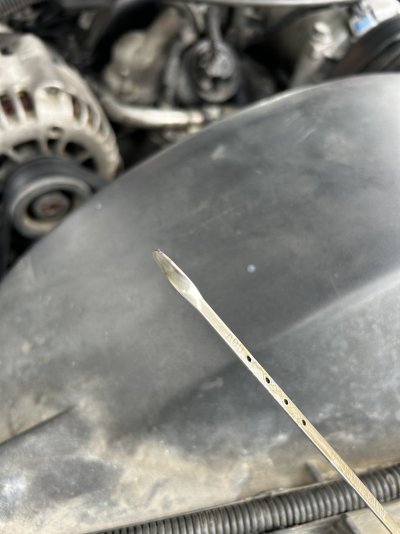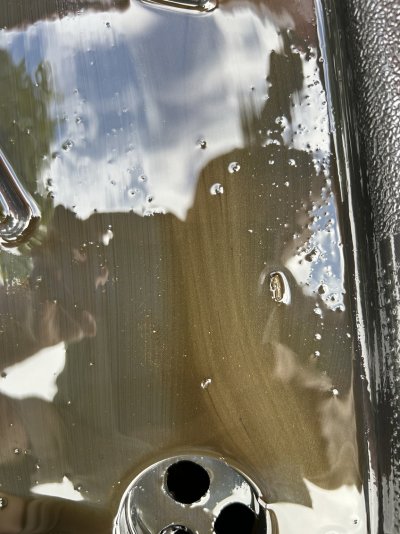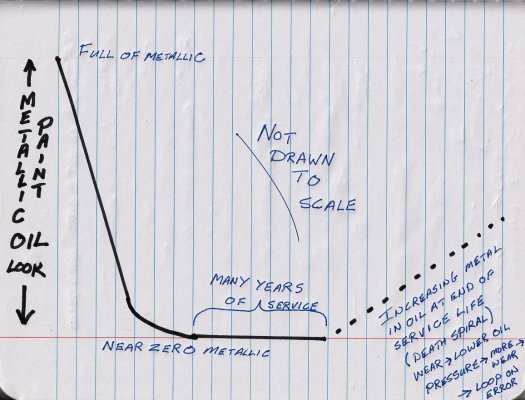So I had engine failure in my 1998 Chevy. Bought a crate 350 from GM and had them install. Did my first oil change to find what looks like someone dumped a bottle of glitter in my engine. Ranges from small particles to large ones. Hopefully these pictures are good enough. I’m aware that for new engines there can be a few shavings and particles, I feel this is excessive though.
You are using an out of date browser. It may not display this or other websites correctly.
You should upgrade or use an alternative browser.
You should upgrade or use an alternative browser.
Crate engine, lots of metal shavings
- Thread starter chapmangd
- Start date
Disclaimer: Links on this page pointing to Amazon, eBay and other sites may include affiliate code. If you click them and make a purchase, we may earn a small commission.
Drunkcanuk
I'm Awesome
Looks like the dealers problem to fix. Don't let them say it's normal....that's definitely excessive.
So I had engine failure in my 1998 Chevy. Bought a crate 350 from GM and had them install. Did my first oil change to find what looks like someone dumped a bottle of glitter in my engine. Ranges from small particles to large ones. Hopefully these pictures are good enough. I’m aware that for new engines there can be a few shavings and particles, I feel this is excessive though.
What are your oil pressures? Especially at a hot idle? And is this reading from the factory gauge?
Or are you using an aftermarket mechanical oil pressure gauge to monitor your new motor?
You mention engine failure in your post. Does the engine no longer run? Is it quiet in operation,
or are there clicks/clacks/taps/raps/knocks occurring? If there are sounds, are they constant, or
do they only occur during initial startup & disappear after a few seconds?
How many miles are on the oil you changed?
****
For what it's worth, on a brand new or (remanufactured) engine it's not unusual for the first
oil change to look like metallic gold paint. And there can be some swarf that wasn't found after
some machining operation was performed. But as long as the amount of glitter in the oil
continues to decrease with every subsequent change, you should be alright.
In the meantime, in order to protect your warranty, I would start carefully documenting everything,
timeline style. And if whoever is backing up the warranty has a list of requirements that you must
follow (like *they* have to replace the oil, or have the oil changes documented by a trusted service
provider) ...then please do so.
So don't panic just yet. But *do* document with due diligence. And if it was me I would talk to
whoever did the work and let them know about your concerns & show them the photos. (And if
the dealership did the work, then make sure that this is all documented against the original
work order #, so that there's history of this being discovered before the warranty expires.)
FWIW I've attached a crude hand-drawn curve that I use to set realistic expectations for a
DIY'er who is repowering their pride & joy before their first oil change. In a dark garage all
can look fine in the drain pan, but when you bring that pan out into the bright sunlight it
really can put the fear of engine failure in you.
If you could provde a few answers to the questions I posed at the beginning then we can
perhaps give you a little less generic advice.
Fingers crossed that your engine is quiet, your oil pressure is robust, and that your first
oil change is just a glittery mess.
Attachments
Last edited:
So the first engine had oil pressure failure with a rod knock. This new engine is still running and is quiet, oil pressure at cold start is 80psi, then drops between 40-80 depending on idle or is accelerating/regular driving speed. The gauge itself is stock, as for the sensor I don’t know if it’s been replaced. This change was done after 500-1,000 miles. I’ve saved the filter and used oil, receipt and time stamp of the mileage and day of change, and will be ordering two oil test kits and changing the oil in another 1-2k miles. Doesn’t contaminated oil affect its efficiency? So running this dirty oil could be decreasing my overall mileage I’ll get out of this motor?What are your oil pressures? Especially at a hot idle? And is this reading from the factory gauge?
Or are you using an aftermarket mechanical oil pressure gauge to monitor your new motor?
You mention engine failure in your post. Does the engine no longer run? Is it quiet in operation,
or are there clicks/clacks/taps/raps/knocks occurring? If there are sounds, are they constant, or
do they only occur during initial startup & disappear after a few seconds?
How many miles are on the oil you changed?
****
For what it's worth, on a brand new or (remanufactured) engine it's not unusual for the first
oil change to look like metallic gold paint. And there can be some swarf that wasn't found after
some machining operation was performed. But as long as the amount of glitter in the oil
continues to decrease with every subsequent change, you should be alright.
In the meantime, in order to protect your warranty, I would start carefully documenting everything,
timeline style. And if whoever is backing up the warranty has a list of requirements that you must
follow (like *they* have to replace the oil, or have the oil changes documented by a trusted service
provider) ...then please do so.
So don't panic just yet. But *do* document with due diligence. And if it was me I would talk to
whoever did the work and let them know about your concerns & show them the photos. (And if
the dealership did the work, then make sure that this is all documented against the original
work order #, so that there's history of this being discovered before the warranty expires.)
FWIW I've attached a crude hand-drawn curve that I use to set realistic expectations for a
DIY'er who is repowering their pride & joy before their first oil change. In a dark garage all
can look fine in the drain pan, but when you bring that pan out into the bright sunlight it
really can put the fear of engine failure in you.
If you could provde a few answers to the questions I posed at the beginning then we can
perhaps give you a little less generic advice.
Fingers crossed that your engine is quiet, your oil pressure is robust, and that your first
oil change is just a glittery mess.
That’s what I’m thinking. I definitely don’t let the dealer push me around. Already had to take is back multiple times for little problems here and there and haven’t paid a dime yet.Looks like the dealers problem to fix. Don't let them say it's normal....that's definitely excessive.
Here's what mine looked like before the #5 rod bearing decided to chew itself up and spit it out.
Kinda looks like yours but, a little worse.
Then, another 500 miles later it played taps... "I think it's dead"
#5 rod bearing.
I'd take it back ASAP.
Kinda looks like yours but, a little worse.
You must be registered for see images attach
Then, another 500 miles later it played taps... "I think it's dead"
You must be registered for see images attach
You must be registered for see images attach
#5 rod bearing.
You must be registered for see images attach
I'd take it back ASAP.
Re: Debris inside a freshly machined engine
Recently it was announced that Brand T is going to recall 102,000 vehicles and
replace the V6 engine due to Foreign Object Damage (FOD) caused by leftover
debris from machining operations that were performed during initial manufacturing.
Low tech report: (R&T article on Brand T recall)
Here's a slightly more technical thread where more heat than light was shed on how lean
modern manufacturing techniques can cause problems like this to crop up even
at Brand T: (Recall of 102,000 vehicles due to engines failing from mfg debris)
This problem can occur anywhere to any OEM. Once upon a time vigilant operators who
took pride in their work, backed up by a solid QA program kept this issue to a tiny fraction
of the total output from an engine plant. Not to be a Negative Nancy, but with fully
automated processes, lean mfg techniques, etc., it's not a surprise that this kind of thing
is occurring on a more frequent basis as time marches on.
File under Things that make you go Hmmm...
Recently it was announced that Brand T is going to recall 102,000 vehicles and
replace the V6 engine due to Foreign Object Damage (FOD) caused by leftover
debris from machining operations that were performed during initial manufacturing.
Low tech report: (R&T article on Brand T recall)
Here's a slightly more technical thread where more heat than light was shed on how lean
modern manufacturing techniques can cause problems like this to crop up even
at Brand T: (Recall of 102,000 vehicles due to engines failing from mfg debris)
This problem can occur anywhere to any OEM. Once upon a time vigilant operators who
took pride in their work, backed up by a solid QA program kept this issue to a tiny fraction
of the total output from an engine plant. Not to be a Negative Nancy, but with fully
automated processes, lean mfg techniques, etc., it's not a surprise that this kind of thing
is occurring on a more frequent basis as time marches on.
File under Things that make you go Hmmm...
Last edited:
So running this dirty oil could be decreasing my overall mileage I’ll get out of this motor?
As long as you changed the oil within the mileage limits set by your warranty you should
still be covered if this level of a fix is necessary. For my own engines where I'm spending
my own money/my friend's money, normally after the first fire I'll run the engine for an hour
or two, including a 90 minute ring-seating/break in session on the open road, followed immediately
by draining the oil, looking for trouble, removing the filter and cutting it open, again looking
for trouble and hoping to not find any, etc.
Then the 2nd batch of fresh oil goes in, and we repeat the drill at ~500 miles, then stretching
the change interval to 1,000 miles, until the metallic glitter tapers off, and then reverting to
the 'normal' 3K oil change intervals. While all this is going on, IF the metallic glitter is steadily
decreasing, change after change, then the situation is under control.
On the other hand, if I get a lot of glitter on the initial oil change, followed by even more glitter
on 2nd and subsequent changes, then I've lost control of the situation, the engine has to
come out, and the root cause of where all this metallic debris is coming from has to be figured out.
And of course, the decision has to be made whether a full do-over is to be started or if the
project is abandoned. (!)
****
By the way, for future readers, if you have a high mileage engine that starts to shed a lot of
metallic debris into the oil, and one or more lifters have become noisy due to a failed cam lobe
and associated lifter failure, then this is the reason why you can't just swap in a new cam and
lifters & expect a long-term fix.
For the failing cam & lifters has contaminated the interior of the engine with extremely hard metallic
debris, and not if but when this contamination ends up trapped in the tightest clearances inside
the motor, this is where you find out that the soft bearing materials can only embed so much FOD
before excess wear occurs, the oil pressure drops, and finally the engine starts to audibly rap/knock.
(Audible death spiral.)
This new engine is still running and is quiet, oil pressure at cold start is 80psi, then drops between 40-80 depending on idle or is accelerating/regular driving speed. The gauge itself is stock, as for the sensor I don’t know if it’s been replaced. This change was done after 500-1,000 miles. I’ve saved the filter and used oil, receipt and time stamp of the mileage and day of change, and will be ordering two oil test kits and changing the oil in another 1-2k miles.
Sounds like you have covered your bases. If this was mine, I'd continue to listen carefully to
your new engine for any signs of emerging noise. And I would change the oil at 1,000 miles, and if you
could, take the sharpest pictures possible of the drain pan in plenty of light. I like the fact that you are
employing a couple of diagnostic test kits to cover the next couple of changes.
NOTE: I'm not as yet advocating for an engine swap, because who's to say that the replacement
engine will be any better? Or possibly worse? But if the dealership needs to replace the oil and
then 'seal' the motor in order to protect the warranty, then you have to follow their rules of
engagement. (Schurkey had some good guidance on all this crate motor warranty stuff
elsewhere in the forum. Recommended reading.)
Stay vigilant. Best of luck --
Last edited:
Similar threads
- Replies
- 48
- Views
- 3K
- Replies
- 21
- Views
- 5K
- Replies
- 7
- Views
- 3K
- Replies
- 6
- Views
- 2K
- Replies
- 15
- Views
- 971
Members online
- Calebz71
- KY-N
- Caman96
- sethturbo
- gewaun
- stikxs
- tmcnurla
- Rimshot133
- ctbhess
- Charlesteneows
- Das Hatt
- AboveTheLogic
- 1998chev454
- Rustyjunk
- jackrabbitZ71
- 99xcss4
- Spareparts
- caw_86
- mbmoehl
- movietvet
- OBS_Alex
- Brandon22083
- mick1140
- lj502
- vantage11
- joeminer81
- young005
- Chagospot99
- man-a-fre
- Jake_Caulley
- kenh
- Strages
- Niesop
- PlayingWithTBI
- robguitargod1
- Jnance94
- termite
- kmoto
- Portcityep
- Sunkentoy
- 95YardArt
- Bcook765
- BNielsen
- 96CK
- BadCompany750
- konajoe
- BeXtreme
- brazzos6
- Orpedcrow
- Bodaddy1
Total: 1,477 (members: 70, guests: 1,407)




